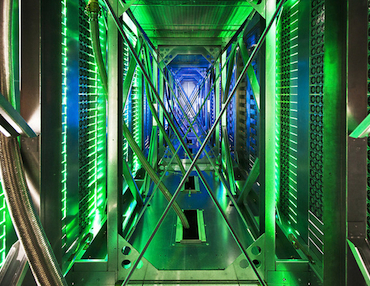Future Datacenters Will Divvy Up Computing, Storage

The datacenter ecosystem of the next decade is likely to resemble an expanded version of the hyperscale facilities currently being built out by today's Internet giants, cloud providers, and software service providers, according to an industry survey on the future of datacenters.
Emerson Network Power led the Data Center 2025 initiative designed to explore trends in the booming datacenter business. The company, which provides power infrastructure to datacenters and communication networks, said its survey includes responses from more than 800 industry executives. Most of the respondents work in IT, banking, manufacturing, telecommunications, and energy sectors.
The survey noted that today's datacenters would be roughly halfway through their projected lifecycle by 2025. The trend is toward mega-datacenters increasingly specialized by function and geographic location.
With a high priority on keeping costs down and ensuring scalability, "hyperscale datacenters are driving increased focus on hardware standardization, infrastructure innovation, and modular expansion," the survey concluded.
Whatever their scale, future datacenters are likely to be more automated, incorporating more solid-state storage and optical communications technologies.
The assessment of one industry consultant was representative of many of the survey's findings: "Most of our new datacenter demand is driven by storage and the need to not only store data but also to use it and access it," KC Mares, CEO of MegaWatt Consulting, told the study's authors.
"We'll have really big datacenters that are focused on just storing data and then we'll have also have really big datacenters that are just focused on using this data, processing it, to provide really quick answers back to us."
"There will probably more sharing between various different datacenters of different companies and different institutions and even government to share data and utilize it," Mares added.
That doesn't mean human-scale datacenters will go away over the next decade. Mare predicted that medium-sized datacenters would appear in "much more diverse locations" to meet regional needs as more users access the Internet. At the same time, these mid-sized facilities will provide geographic redundancy for the global network of datacenters, Mares said.
Based on their assessments, the survey's authors lumped respondents into three categories: conservatives (37 percent), moderates (41 percent), and progressives (22 percent). One metric illustrates the outlook for each group: Conservatives envision 60 percent of computing handled in the cloud by 2025. That estimate rose to 70 percent for moderates and 81 percent among progressives.
As datacenter administrators focused more attention on energy usage over the last several years, they looked for ways to boost capacity utilization. Virtualization of the datacenter, which "broke the connection between applications and physical services," provided one path. "By increasing server utilization, virtualization has the potential to increase server efficiency and reduce overall datacenter energy consumption," the report found.
Indeed, virtualization contributed the highest percentage of energy savings in Emerson's Energy Logic model.
Still, some analysts think current efforts to reduce datacenter power usage effectiveness, or PUE, may be hitting a wall. A recent Uptime Institute survey found that average industry PUEs are actually trending back up. "This is called diminishing returns," said analyst Matt Stansberry.
Meanwhile, the primary concerns of datacenter operators have shifted away from heat and power density along with energy efficiency since 2007. In 2013, the Emerson survey found that the top concern among members of the Data Center Users Group, which Emerson Network Power sponsors, was datacenter monitoring and infrastructure management.
The rise of hyperscale datacenters is also prompting "a shift in enterprise IT management away from owned IT assets to acquiring computing as a service or utility," Emerson found.
Along with the growing need for security as more public and government sector data is shared, big data is expected to have a major impact on the future datacenter. Big data "could have significant impact on datacenters and networks in the future as terabytes become zettabytes," or 1 billion terabytes, the survey stressed.
Related
George Leopold has written about science and technology for more than 30 years, focusing on electronics and aerospace technology. He previously served as executive editor of Electronic Engineering Times. Leopold is the author of "Calculated Risk: The Supersonic Life and Times of Gus Grissom" (Purdue University Press, 2016).













